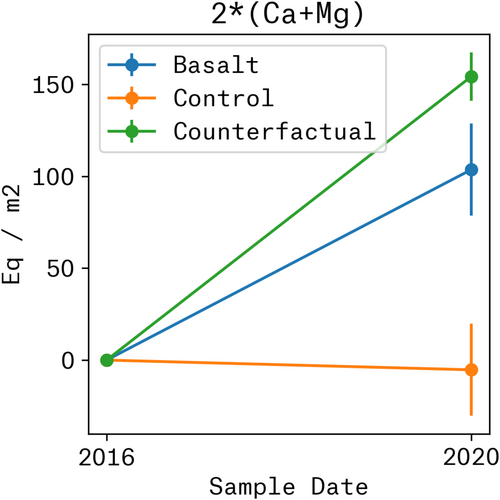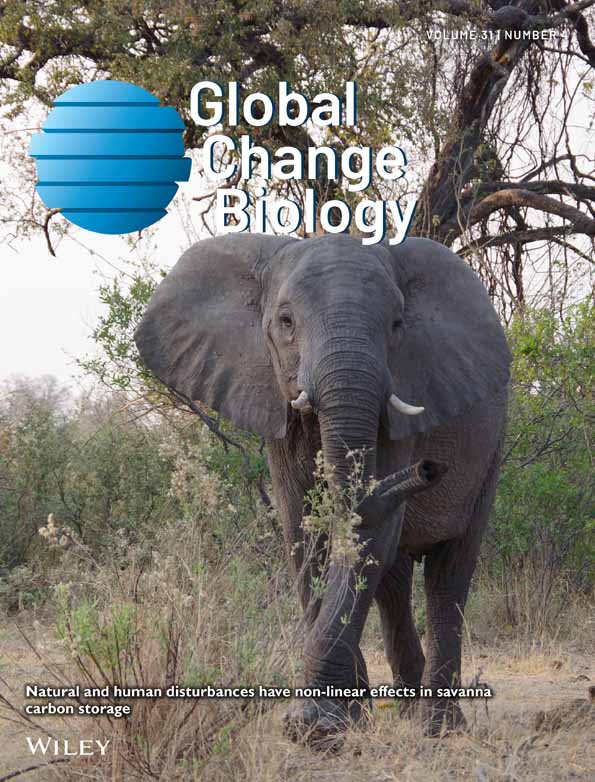Statistical Analysis of Basalt Weathering Disproves the Null Hypothesis
Abstract
This article addresses several concerns raised about the methods employed to quantify carbon dioxide removal via enhanced rock weathering. We showed that the rock analysis data used is indeed of sufficient quality, that the randomized complete block design does indeed show statistically significant cation loss above baseline, and finally that the immobile tracer approach to quantifying application rate is statistically significant. We acknowledge that analytical noise broadens the error bars for the application rate estimation.
In addition to increasing net primary production, Kantola et al. (2023) demonstrated that enhanced weathering of applied basalt increased carbon (C) uptake in maize/soybean and bioenergy Miscanthus agroecosystems by 102 g C m−2 y−1 and 234 g C m−2 y−1, respectively. Derry et al. (2025) have raised concerns about the methods used to calculate EW in this paper. Here, I respond to their three core concerns.
1 Is the Data Quality for the Added Basalt Sufficient?
Derry et al. observed that an elemental analysis of the Blue Ridge Metabasalt (BRMB) cited by Kantola et al. sum only to 78% rather than 100% and therefore question the quality of these data. A closer inspection of Kantola et al. and the data provided by ActLabs which analyzed the chemical composition indicates that the loss on ignition (LOI) for BRMB was ~5%, explaining part of the discrepancy. The remaining discrepancy appears to be tied to the strength of the digest used in Lewis et al. (2021), as applied to the particular mineralogy of BRMB. The mineralogy of BRMB use in Kantola et al. was initially described in Lewis et al. (2021) and is cited by Derry et al.; in this paper a 1-acid hydrofluoric (HF) digest was employed, which is not quantitative. Rather, Kantola et al. relied on data from ActLabs which employed a lithium borate ‘total fusion’ analysis, the most rigorous option. According to ActLabs, weaker digests, including 4-acid digests using HF, “…may not be total due to the mineralogy present in the samples”. Several analyses of BRMB, submitted by different groups to ActLabs and collected by the author, all sum to 100%.
2 Was There a Statistically Significant Loss of Magnesium (Mg) and Calcium (Ca)?
Leaching of Mg and Ca through the soil column charge balances the leaching of bicarbonate, and measurement of the loss of these cations is central for calculating CDR by EW. Derry et al. incorrectly claim that Kantola et al. did not statistically resolve these losses between treatment plots and estimates of the rock-amended baseline. To calculate Mg and Ca losses, Kantola et al. measured the mean addition of base alkalinity (i.e., 2*(Mg + Ca) in equivalents per m2) and the change in alkalinity in the amended plots. An analysis of variance for the experiment was conducted by the author to estimate the uncertainty in this quantity. In addition, Kantola et al. accounted for the charge removed by plant uptake of Mg and Ca relative to the control plots, as well as the charge offset by nitrate, again relative to the control plots. The values for base alkalinity clearly diverged between treatment plots and the rock-amended baseline over the course of the experiment (Figure 1), with no overlap of the 95% confidence intervals, demonstrating statistically resolved differences in the loss of these cations in the amended plots, providing clear evidence of the weathering and loss of applied cations.

3 Are Rare Earth Elements (REE) Suitable to Constrain Basalt Application Rates?
Kantola et al. plotted (REEpost application—REEpre application) versus REEbasalt to estimate the actual basalt application rate, where the basalt spreader was set to 5 kg m−2 y−1 (20 kg m−2 5 yrs−1). Using a Monte Carlo simulation of the slope and assuming 4% analytical uncertainty, Derry et al. estimated a similar slope as Kantola et al. but with greater variance and claimed the slope could not be resolved from zero, thus invalidating this approach to estimating basalt addition. The actual analytical uncertainty from ActLabs varies in the Lanthanides from 0.6% (for Neodymium) to 13.8% (for Thallium). We conducted a Monte Carlo analysis of the slope, incorporating this added uncertainty, and arrived at a similar result as Derry et al. The original paper reported a slope of 0.041 (standard error (SE) of 0.0027), Derry reported a slope of 0.037 (SE of 0.013), and the result here of the Monte Carlo analysis using observed errors was 0.045 (SE of 0.0085). Using Neodymium alone results in a slope of 0.046 (SE of 0.0049), suggesting that much of the error was driven by tracers with low signal against the soil background; the approach in the original paper to set the intercept to zero likely reduced the uncertainty in the slope. Nevertheless, in all of these cases, the slope was statistically different from zero. It is therefore reasonable to conclude that using REE to constrain the basalt addition rate was appropriate and accurate when values are averaged across plots. It is noteworthy that the basalt application rate estimated from REE in Kantola et al. was within 1% of the application rate set by the basalt spreader, further validating this approach.
Derry et al. quite reasonably point out that low signal-to-noise ratios greatly complicate soil chemical analyses, which is why Kantola et al. relied on average values among plots for field level cation budgets and the use of REEs for estimating basalt application rates. Future research would benefit from considerably larger sample sizes to overcome observational noise or strategies to reduce soil background variation. Given the challenges inherent in this type of research, it was encouraging that Beerling et al. (2024) reported CDR on these same maize/soybean plots, but using independent data and methods, of 130 ± 75 g C m−2 y−1, a value not significantly different than that of Kantola et al. (2023).
Acknowledgements
The author is a founder of Eion Corp, an enhanced rock weathering company.
Conflicts of Interest
The author declares no conflicts of interest.
Linked Article
This article is a Response to a Letter to the Editor by Derry et al., https://doi.org/10.1111/gcb.70067 regarding Kantola et al., https://doi.org/10.1111/gcb.16903.
Open Research
Data Availability Statement
The data and code that support the findings of this study are openly available in data repository https://doi.org/10.5281/zenodo.15218029.




